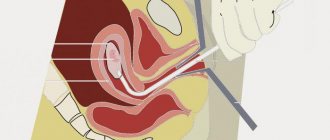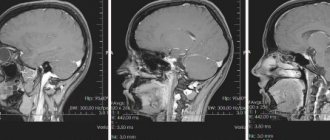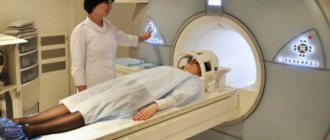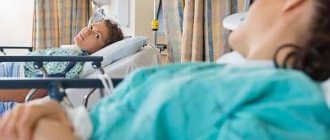Laparoscopy is one of the low-traumatic methods of surgical gynecology, which allows you to do without a layer-by-layer incision of the abdominal wall. The uniqueness of this operation lies in the access to the operated organs. The operating surgeon makes small punctures on the anterior abdominal wall no larger than 5-7 millimeters in size, which heal quite quickly in the postoperative period. Through these incisions, during the operation, a special optical device is inserted to visualize the surgical field - a laparoscope, which is a flexible tube equipped with a lens system and a video camera.
With the help of a clear image, the specialist is able to examine reproductive organs that are not visible during a routine gynecological examination. This method of surgical correction of a pathological defect provides patients with the opportunity to avoid long and difficult rehabilitation. The hospital period after laparoscopy of an ovarian cyst lasts only a couple of days, after which the woman’s body fully recovers from the surgical intervention.
In this situation, obtaining and validating a sick leave certificate after laparoscopy of an ovarian cyst is one of the key points in the treatment of patients who are about to undergo surgery. Oddly enough, in most cases it all depends on the complexity of the operation, intraoperative complications and their consequences.
Following the latest trends in medicine, doctors at the Oncology Clinic of the Yusupov Hospital use in their practice only minimally invasive surgical operations to treat various diseases of the female reproductive system. The constant exchange of experience with other European clinics allowed the clinic’s specialists to expand their range of diagnostic and treatment services. In a hospital inpatient department, the patient is consulted by several doctors at once (therapist, cardiologist, endocrinologist, neurologist, etc.). After the first stage of treatment, an individual rehabilitation program is created for each patient to minimize unwanted complications from the treatment.
When is the checkout made?
Each person's postoperative time spent in the hospital is different. This depends on the patient’s condition, his psychological mood, the reason for laparoscopy, the presence of concomitant diseases, and what age the patient is. There are times when he goes home just a few hours after the operation, after the effect of the anesthesia wears off.
Some will need at least 2-3 days, while others will be discharged from the hospital after a week. This depends not only on the healing process of scars on the skin, but also on the condition of the internal organs, since they were disturbed during surgery.
This usually happens after:
- 1–3 days – during gynecological surgery;
- 3–4 days – after treatment of the abdominal organs;
- 7–10 hours – during diagnostic procedures;
- 5–6 days – for renal laparoscopy;
- 3–5 days – after intervention on the lung.
What influences the duration of BL?
The duration of sick leave depends on the complexity of the operation. In the case of any operations on the gallbladder, including cholecystectomy, laparoscopy is often used.
This option involves a more gentle intervention, the absence of large sutures and associated healing difficulties, and, accordingly, a significantly accelerated recovery period.
In addition, other factors influence the duration of sick leave:
- the condition of the person being operated on before and after the operation, determined by the general indicators of his health;
- the size of the diseased organ and the extent of surgical intervention;
- the occurrence of complications during and after surgery.
Features of recovery after laparoscopy
After laparoscopy, patients recover faster than after abdominal surgery. Minimally invasive surgery eliminates the need for narcotic pain relief in the postoperative period and reduces the risk of complications.
The patient must adhere to the following rules:
- do not eat until evening;
- drink only still water;
- do not lie on your stomach;
- wear a brace if prescribed;
Possible discomfort after surgery:
- nausea and vomiting:
- dizziness;
- pain at the puncture site;
- nagging abdominal pain similar to menstrual pain;
- severe pain under the ribs and in the collarbones;
- feeling of bloating;
- imaginary fullness of the bladder.
These symptoms are associated with general anesthesia and the introduction of gas into the abdominal cavity and disappear within 1-2 days.
You are allowed to get out of bed 2-3 hours after surgery. In the future, the patient is recommended to walk slowly to stimulate the outflow of gas from the peritoneum. But after the operation, you should preferably sit or lie down for 1-2 days; getting out of bed should be done carefully.
Dressings after surgery
After laparoscopy, the punctures are covered with sutures and bandages. In the hospital every morning they change the dressing and lubricate the seams with brilliant green. They are removed on day 7-8 if they were applied with non-absorbable suture material.
To make a post-operative dressing at home you will need:
- sterile gloves;
- sterile gauze wipes;
- "green";
- hydrogen peroxide;
- sterile tweezers;
- patch;
- alcohol.
Main stages of rehabilitation
The rehabilitation period is divided into two stages according to time indicators. Experts note an early postoperative period (the patient is kept in hospital) and a late one (they are given sick leave); further recovery after surgery to remove the gallbladder is determined by the presence of complications:
- early stage with hospital stay (first two days). At this time, most of the changes in the patient’s body that occurred during the operation and the administered anesthesia appear;
- the late stage of the hospital starts from the third day and up to a week in the case of laparoscopy or two weeks after laparatomy. The patient's pulmonary system and gastrointestinal tract are restored, regeneration occurs in the area of the intervention;
- Outpatient rehabilitation is carried out from a month to three depending on the type of operation. During this period, the patient’s digestion and breathing processes are restored, and human physical activity is gradually introduced;
- course of sanatorium treatment six months after cholecystectomy.
Read also: What is hyperechoic suspension in the gallbladder?
Features of rehabilitation
It is important to know!
78% of people with gallbladder disease suffer from liver problems! Doctors strongly recommend that patients with gallbladder diseases undergo liver cleansing at least once every six months... Read more...
After the first week after surgery, the patient must wear a bandage constantly and adhere to dietary rules. A diet limiting certain foods can help relieve the liver, which has to work in the absence of a bladder. Violation of the diet threatens the patient with chronic hepatitis, since the liver may not cope with the loads placed on it.
The bandage is prescribed to prevent hernia after surgery to remove the gallbladder. These devices tighten the anterior wall of the abdomen, and even if the surgical incision is not sufficiently sutured, the intestines will not fall out into the hernial orifice. It is necessary to take hepatoprotectors that will restore the liver at the cellular level. There are a lot of drugs, each of them has additional medicinal properties.
Physical activity during removal of the biliary organ is limited to six months. Lifting heavy objects and placing stress on the abdomen should be avoided. Sports are allowed in the form of light gymnastics; this is a good prevention of the development of a hernia. The occurrence of hernias disrupts the blood supply to the intestinal tract, which causes its necrosis. Such conditions are life-threatening.
How many days later will they be discharged from the hospital?
You can be discharged from the hospital as soon as your health allows:
- in some cases, the patient goes home immediately after anesthesia;
- on average, they stay in the hospital from 1 to 5 days;
- If the operation was carried out with complications, you will have to stay in the clinic for a long time - up to 10 days.
After the hospital, the patient is transferred to outpatient treatment. You can go to work 3-4 days after discharge from the hospital, but the sick leave is not closed until the stitches are removed.
How long does sick leave last?
Possible periods of sick leave after laparoscopy depend on a number of factors both on the part of the patient and on the part of the attending physician. Regarding the general time frame, the following terms of sick leave can be distinguished:
- Minimal – sick leave is issued for 1 day, namely the day of the operation, which is due to the maximum minimum of consequences arising from the operation, the absence of any intraoperative complications and the possibility of returning to work the next day;
- Medium – sick leave is issued for a maximum of five days, at the request of the patient. This period is quite enough for the postoperative sutures to tighten and not cause much discomfort to the patient with minimal physical activity;
- High – sick leave can be extended by the attending physician for up to 15 calendar days, in the case of heavy physical and mental work and the patient’s general poor health in the postoperative period;
- Maximum - sick leave is issued for a period that will be sufficient to complete the full cycle of rehabilitation measures. This sheet is issued in the event of a critical deterioration in the patient’s well-being, the presence of rather severe postoperative consequences that threaten the patient’s health, or the occurrence of injuries to internal organs.
If these periods exceed a certain general limit, namely 15 days of sick leave plus a one-time 15 days of extension of the medical commission, a sick leave after laparoscopy of an ovarian cyst is issued for a period not exceeding 10 months. This period is the maximum possible for sick leave. Despite this, these points are only an exception to the rule, since laparoscopy is one of the safest methods of surgical treatment.
Yusupov Hospital is a European multidisciplinary center, which includes not only the department of oncology, neurology and therapy, but also a surgery clinic, using advanced technologies and international standards for the quality of medical care. To find out more information about the treatment of cystic ovarian formations, make an appointment with a gynecologist by phone.
Author
Features of nutrition during the recovery period
The day after surgery, the patient can take warm liquid food:
- lean broths (chicken or fish);
- fruit drinks from sour berries;
- jelly;
- drinking yoghurts, etc.
The day after surgery, the patient is allowed a thicker meal:
- porridge;
- kefir and other fermented milk products;
- cheese;
- steamed vegetables;
- steamed meat or fish cutlets;
- soft-boiled eggs;
- baby food in jars (vegetable or meat);
- low-fat soups.
After a week, restrictions are minimized.
The following post-operative diet is suitable:
- porridge with water;
- soups without sauteing;
- steamed meat and fish dishes;
- boiled and steamed vegetables;
- peeled fruits;
- whole grain dried bread;
- Herb tea;
- natural fruit drinks.
Nutrition
While those recovering from appendicitis are in the hospital, they are prescribed a special diet, the observance of which leads to moderate filling of the intestines (prevention of internal adhesions). But compassionate relatives bring non-dietary products to the hospital, which are strictly prohibited during the rehabilitation period:
- fried, fatty, spicy foods;
- foods that cause increased gas formation and peristalsis (danger of increasing intestinal volume and divergence of internal seams) - peas, beans, grapes, raw vegetables and fruits, milk;
- strong meat broths, not minced meat;
- carbonated drinks, sweets, baked goods.
When can you do sports or fitness?
After surgery, physical activity should be limited to walking. You can start working out in the gym in a month, but you need a gentle regime.
The increase in loads should be gradual: it will take 4-5 months to return to the normal rhythm of training.
The increase in sports activity is coordinated with the attending physician and personal trainer.
Exercises after laparoscopy
Physical therapy helps restore the body after surgery. In the first 2-3 days after the procedure, you need to train while lying down.
- breathing exercises;
- turns to one side;
- moving your legs on the bed (imitation of walking).
The intensity of classes increases gradually, while:
- The main exercise after surgery is walking on a flat surface;
- after 4-5 days you can add climbing stairs;
- after a month you can swim in the pool;
- At the same time, they begin to do exercises in the morning: smooth movements are allowed without stress on the abdominal muscles.
Outpatient recovery
On the third day after discharge, a routine examination by a surgeon and therapist is required. It is repeated after a week, then after a month. Blood tests for general examination and biochemical indicators are taken 2 weeks after discharge, as well as after 12 months. An ultrasound is recommended during the first month if necessary, and a follow-up is done a year later.
The patient is allowed to introduce small loads on the abdominal cavity by performing “scissors” on the back with legs crossed or “bicycle”, spinning imaginary pedals in the air. Walks can be extended to one and a half hours if there is no deterioration in health. Breathing exercises continue.
Medicines during rehabilitation
Inna Lavrenko
auto RU
If duodenogastric reflux develops, appropriate anti-reflux medications are needed. Motilium prevents the reflux of bile from the duodenum into the gastric tract. If the mucous membranes in the stomach are affected, antisecretory medications are needed, for example, Omeprazole. Antacids Almagel and Rennie, as well as Maalox can relieve pain and heartburn.
Read also: The best choleretic herbs for gallstones
Drinking mineral water will be beneficial. Essentuki 4.17, Slavyanovskaya and others are recommended in consultation with the doctor. The water is taken exceptionally warm, drunk slowly, four times during the day, half (or slightly less) of a glass. Additionally, physiotherapy in the form of magnetic therapy or ultrasound is prescribed.
Treatment in dispensaries and sanatoriums
Removal of the gallbladder is considered a full-fledged indication for a specialist to refer the patient to a sanatorium-resort treatment. All procedures that are offered in the medical complex of most of these institutions will help restore the normal functioning of various systems in the patient’s body.
Sanatoriums offer:
| № | Helpful information |
| 1 | mineral water treatment course |
| 2 | balneotherapy, carbon dioxide, pine, radon or mineral baths |
| 3 | conducting electrophoresis with succinic acid |
| 4 | treatment with Riboxin and Mildronate |
| 5 | a set of therapeutic exercises and dietary nutrition |
What should not be done after laparoscopy?
After laparoscopy, there are a number of restrictions for the patient, but they are only temporary. Doctors give patients certain recommendations on how to behave during the rehabilitation period and what to eat.
Do not eat:
- spicy;
- salty;
- smoked;
- roast;
- legumes;
- fresh bread and baked goods;
- carbonated drinks;
- coffee;
- alcohol.
For several weeks, depending on how the operation went and what condition the patient is in, it is unacceptable:
- make sudden movements;
- run;
- ride a bicycle (motorcycle);
- lift weights.
Smoking should not be prohibited after laparoscopy: as a result of giving up the habit, the body is cleansed of tar and nicotine, and the person coughs. When you cough, your abdominal muscles and diaphragm become tense, which prevents you from recovering quickly.
You can learn about what you can do after laparoscopy, what actions are prohibited and why, from the video from the Lifehacks channel. Useful tips."
Factors affecting the speed of discharge
In order for the patient to be quickly discharged from the hospital, it is necessary to follow all the recommendations of the attending physician, which primarily relate to regimen and nutrition. The following factors influence how long it takes for a patient to be discharged from the hospital:
- duration of laparoscopic interventions;
- type of anesthesia;
- patient status;
- the presence or absence of chronic diseases complicating the rehabilitation period.
After surgery, doctors first of all pay attention to the following indicators that indicate the person’s condition, which have a direct impact on such a factor as early discharge from the hospital:
- Skin color. If the rehabilitation period continues as usual, it is pale pink.
- Body temperature. Usually it is within 37.5 degrees, which indicates the functioning of the immune system.
- Arterial pressure. It should be the same as before laparoscopy.
- Breath. The normal number of breaths varies from 16 to 18 in 60 seconds.
- The amount of urine discharge. Since it is necessary to exclude stagnation of fluid in the body.
If all indicators are normal, the surgical intervention was successful, without any complications, then the patient is discharged on the 3rd day. Most often, the moment of discharge occurs on the 5th day, after which the sick leave is extended for another 10 days.
During surgery, carbon dioxide is pumped into the abdominal cavity.
Laparoscopy is performed by injecting carbon dioxide into the body, which helps increase intra-abdominal space. After the procedure is completed, it is removed by a special device, but it is possible that a small amount of gas remains in the abdominal cavity. This causes quite serious discomfort in the lungs and stomach.
If health does not improve within 2–3 days, then doctors leave the patient in the hospital longer to monitor him. Despite the fact that laparoscopy is a minimally invasive method, to speed up the rehabilitation period you should follow all the recommendations of the attending physician. It is better to stay in the hospital for as long as it takes to fully recuperate.
Electrophoresis and physiotherapy during the recovery period
Physiotherapy is required due to gynecological operations on the following organs:
After treatment of fallopian tube obstruction, the following physiotherapy procedures are performed:
- compresses made of ozokerite or paraffin;
- medicinal electrophoresis.
Based on the results of treatment of the ovaries, removal of myomatous nodes and enlarged endometrium, in addition to electrophoresis, magnetic therapy is used.
Physiotherapeutic methods are used to prevent adhesions from forming after laparoscopy.
Physiotherapy is not required after diagnostic laparoscopy.
Recommendations for recovery
The main rehabilitation period is short - it takes from 1 to 4 weeks. For a quick recovery after laparoscopy you need to:
- adhere to a strict diet for the first 7 days after laparoscopy - eat food at room temperature and puree-like consistency;
- give up fatty, fried, canned, smoked foods for a month;
- enrich your diet with healthy foods high in vitamins and beneficial elements;
- Avoid alcohol and cigarettes for at least 4 weeks;
- do not take a bath or go to the sauna or solarium for 6 weeks;
- avoid prolonged exposure to the sun and hypothermia;
- do not fly on airplanes and avoid long trips;
- adhere to sexual rest for a month;
- do not lift more than 3 kg until complete rehabilitation;
- gradually move on to physical activity - for the first month only leisurely walks are allowed, then include therapeutic exercises;
- strictly follow the doctor’s recommendations and take prescribed medications - they cannot be canceled, if this is done at your own discretion, there is a high risk of complications.
If laparoscopy was performed on a woman, she also needs:
- wear a bandage for the first 3–4 days to restore the tone of the abdominal muscles;
- go to the gynecologist - he prescribes further treatment and determines when it is possible to allow sex and pregnancy planning;
- perform special exercises to prevent adhesions;
- If other gynecological pathologies are detected, you need to be treated.
A certificate of incapacity for work after laparoscopy is issued for an average of 15 days. But if there are complications, it is extended. Typically, patients are on sick leave for a month, but according to indications, the period is increased to a year.
An important part of recovery is movement. Walking, slowly to begin with, activates the intestines, improves blood flow and metabolic processes in the pelvis, eliminating stagnation.
The key to full recovery is dietary nutrition. You won’t have to go on a diet for a long time; it only takes a month.
Possible complications
The most common complication is infection at the puncture site. Then antibiotic therapy is prescribed, and a course of immunostimulants is recommended.
The following complications lead to negative health consequences:
- development of necrosis and peritonitis when large vessels are damaged during surgery;
- internal bleeding due to insufficient cauterization of blood vessels;
- infection and development of sepsis due to non-compliance with sterility;
- blood clot formation;
- development of heart failure;
- allergy to anesthetics or carbon dioxide filling the abdominal cavity.
In modern clinics, complications during laparoscopy do not exceed 2%.
In what cases can sick leave be extended?
Sometimes the doctor issues an additional one to the main certificate of incapacity for work. As a rule, during laparoscopy, which is not a complex type of intervention, this happens extremely rarely.
In most cases, the decision to extend sick leave is made if:
- there are postoperative complications (damage to internal organs or blood vessels, thrombus formation, infection of sutures, malfunction of the cardiac system after anesthesia, infectious and inflammatory processes, etc.);
- there is a need for repeated surgery.
24 days - this is the length of additional sick leave you can count on in case of a burdened postoperative period. Dear readers! Our articles talk about typical ways to resolve legal issues, but each case is unique.
If you want to find out how to solve your particular problem, please use the online consultant form on the right or call:
7;
It's fast and free!
Planning pregnancy after laparoscopy
You can usually plan a pregnancy after laparoscopy within a few weeks. The duration depends on the purpose of the operation.
If the operation was performed for diagnosis, then conception is possible in the next cycle.
During laparoscopic treatment of a number of diseases, it is recommended to become pregnant within the following periods:
- after removal of myomatous nodes - a year later;
- after infertility treatment - in the next cycle;
- after cystectomy of an ovarian cyst - after 2 months.
Recovery period without complications
If there are no complaints from the patient, upon examination by medical personnel after 2-3 days, he is allowed to stand up and try to walk.
This is possible in the absence of hyperthermia, inflammation of the suture, or pus at the incision site. It is advisable to try to stand up under the supervision of a specialist, but if you feel well, walking independently is possible.
If the removal was carried out using the laparoscopy method, on the third day the doctor will prescribe removal of the suture. But with a standard incision, the patient waits several more days.
It is important to monitor the condition of the seam, try not to get it wet when taking a shower, and treat it with special disinfecting solutions in a timely manner.
With a stable state of health and positive dynamics of recovery, the patient is discharged from the hospital on the 10th day. This does not mean that you can return to your previous lifestyle right away. The recovery period lasts at least 8 weeks. The patient is at home, he is not kept in the hospital, but at this time it is important to follow all instructions, doctor’s recommendations, follow a diet, refuse to attend training in the gym, or heavy physical labor. If the patient’s work activity is associated with physical labor, he is transferred to light labor.
Description of the operation of laparoscopy of an ovarian cyst. The period of hospital stay after it
IT IS IMPORTANT TO KNOW! An effective remedy for CYSTS without surgery and hormones, recommended by Irina Yakovleva! Read more…
Often, women aged 25 to 45 years old who come for a regular examination to a gynecologist hear a disappointing diagnosis: an ovarian cyst. But do not immediately panic - with timely diagnosis and proper treatment, begun at the earliest stages of the disease, the woman can expect a complete recovery and a return to a full, active life. For the treatment of ovarian cysts, an integrated approach is most often used, including traditional drug therapy, herbal medicines, a set of various physiotherapeutic procedures, and in the most severe cases, surgical treatment. One of the most common and frequently prescribed methods of surgical intervention for ovarian cysts is laparoscopy. Many women who have been diagnosed with this gynecological pathology ask a completely logical question: what is this technique for removing a cyst and how long do you need to stay in the hospital after this operation?
Laparoscopy: essence and technique
Laparoscopy is an endoscopic surgical intervention in the ovarian region, which is performed without direct penetration into the abdominal cavity.
How is an ovarian cyst removed by laparoscopy? This type of surgical treatment is performed only under general anesthesia. The surgical intervention is performed through three small incisions in the abdominal cavity - the diameter of each hole usually does not exceed 0.5 - 1 cm. Next, carbon dioxide is injected into the internal abdominal cavity, which helps create the necessary surgical space. This becomes possible due to the fact that after the gas is introduced, the walls of the abdominal cavity are raised above the internal organs, providing free access to them.
Through the holes, the surgeon inserts a miniature camera and flashlight, as well as special surgical instruments. Next, all the necessary surgical procedures are performed to remove the cyst, and the holes made are sutured.
The widespread use of laparoscopy is due to its many advantages over other types of surgical treatment.
- There is no direct penetration into the abdominal cavity, which cannot be avoided during a conventional operation - accordingly, laparoscopy is an absolutely non-traumatic type of surgical intervention.
- The postoperative period for laparoscopy is much shorter than for traditional surgery.
- Both during and after laparoscopy, the woman is not accompanied by pain. Another advantage of this technique is the absence of postoperative scars and rough scars.
- With this type of cyst removal, there is no possibility of sutures coming apart or developing various inflammatory, infectious and adhesive processes.
Preparation for laparoscopy
The first stage of preparation for the operation is that the woman must undergo all tests and undergo all examinations prescribed by the doctor. In the vast majority of cases, we are talking about a urine test, a general blood test, a study of coagulation and glucose levels, and an ultrasound examination of the pelvic organs. The operation to remove an ovarian cyst can be performed on any day of the menstrual cycle - except those directly on which menstruation falls.
The day before laparoscopy, the woman goes to the inpatient department of the hospital. Since the removal of the cyst is performed under general anesthesia, she is allowed to eat until approximately 18:00 the day before, and drink until 21:00 - 22:00. On the day of surgery, drinking any liquid is strictly prohibited. Before the operation, the external genital area is carefully shaved. To cleanse the stomach as much as possible in the evening, before bed, and immediately before surgery, the woman is given cleansing enemas.
First day after surgery
On the first day after laparoscopy of an ovarian cyst, the woman must be in the hospital under constant medical supervision. This is due to the fact that after the anesthesia wears off, the patient may experience pain of varying degrees of intensity in the lower abdomen. Also on the first day, medical staff treats postoperative sutures.
Approximately 7 - 8 hours after laparoscopy, a woman can drink still water, freshly squeezed juices, compotes, and fruit drinks. At the same time, you are allowed to get out of bed - but under no circumstances should you make any active or sudden movements. If the pain in the ovarian area is quite severe, the doctor may prescribe certain medications from the analgesic category. Also, in the vast majority of cases, antibiotic therapy is prescribed - this is necessary in order to minimize the risk of developing any complications.
Postoperative period
As a rule, the duration of the recovery period after laparoscopy to remove an ovarian cyst entirely depends on the individual characteristics of each specific female body. In most cases, you will have to stay in the hospital for 3 to 7 days. It all depends on how quickly the postoperative sutures heal, how soon they will be removed, as well as on the woman’s general well-being. Of course, if there are any complications of laparoscopy or severe pain in the ovaries, the length of hospital stay may be slightly increased.
Usually, for 7 days after removal of the ovarian cyst, the patient undergoes regular treatment of the sutures, which consists of changing the bandage and thoroughly treating the sutures with a special antiseptic. Also, throughout the entire postoperative period that the woman spends in the hospital, she is recommended to move as much as possible, starting with slow walking. This is necessary in order to completely restore and activate intestinal motility, as well as the general functioning of the ovaries and other internal genital organs. On days 5-7 after surgery, provided the woman is in good health, the stitches are removed and the patient is discharged from the hospital.
However, one should not think that the recovery period after surgical removal of an ovarian cyst ends with discharge from the hospital. A woman can count on a full return to her normal activities no earlier than a month after laparoscopy. For approximately 23 to 25 days after discharge from the hospital, you should strictly adhere to certain rehabilitation rules.
By secret
- Incredible... You can cure a cyst without surgery!
- This time.
- Without taking hormonal drugs!
- That's two.
- Per month!
- That's three.
Follow the link and find out how Irina Yakovleva did it!
It is important to know! ×
aginekolog.ru
Progress of the operation
Laparoscopy takes place in several stages:
- Using general anesthesia, a urinary catheter is inserted. In the first minutes after the anesthesia is administered, it may be difficult to breathe.
- Three small incisions are made in the anterior wall of the abdomen.
- Cameras and instruments are passed through the incision.
- A special gas is pumped into the abdominal cavity.
- After examining the damaged organ, the surgeon makes an incision in the ovarian tissue and begins to suck out the fluid filling the cyst.
- To prevent adhesions from appearing, excess epithelium is removed or sutured.
- All surgical instruments are removed and the gas is pumped out.
- The two incisions are sutured and a drainage tube is placed in the remaining hole.
Legal side of the issue
The start date of the sick leave is the day of hospitalization, and the end date is the last day of inability to perform your work. The document is drawn up by the attending physician, who decides the duration of the period of temporary disability for this patient. As an exception, a bulletin on the health status is given by the doctor of the clinic who referred the woman to the hospital to continue therapy.
If the patient needs to travel to another area to receive medical advice or professional assistance, then the time spent on the road is also counted towards the duration of the temporary disability certificate.
It is necessary to visit the doctor on the day indicated by him for the possible closure of the sick leave. Otherwise, the specialist will make a note on the official document about the violation of the regime, which will allow the employer not to pay for the period of temporary disability in full.
The sick leave certificate is submitted to the human resources department, accounting department, or directly to the head of the organization in which the woman works. If the patient works in several places at once, then she must provide one copy of the document to each of them. It is important that each of them is designed correctly.











